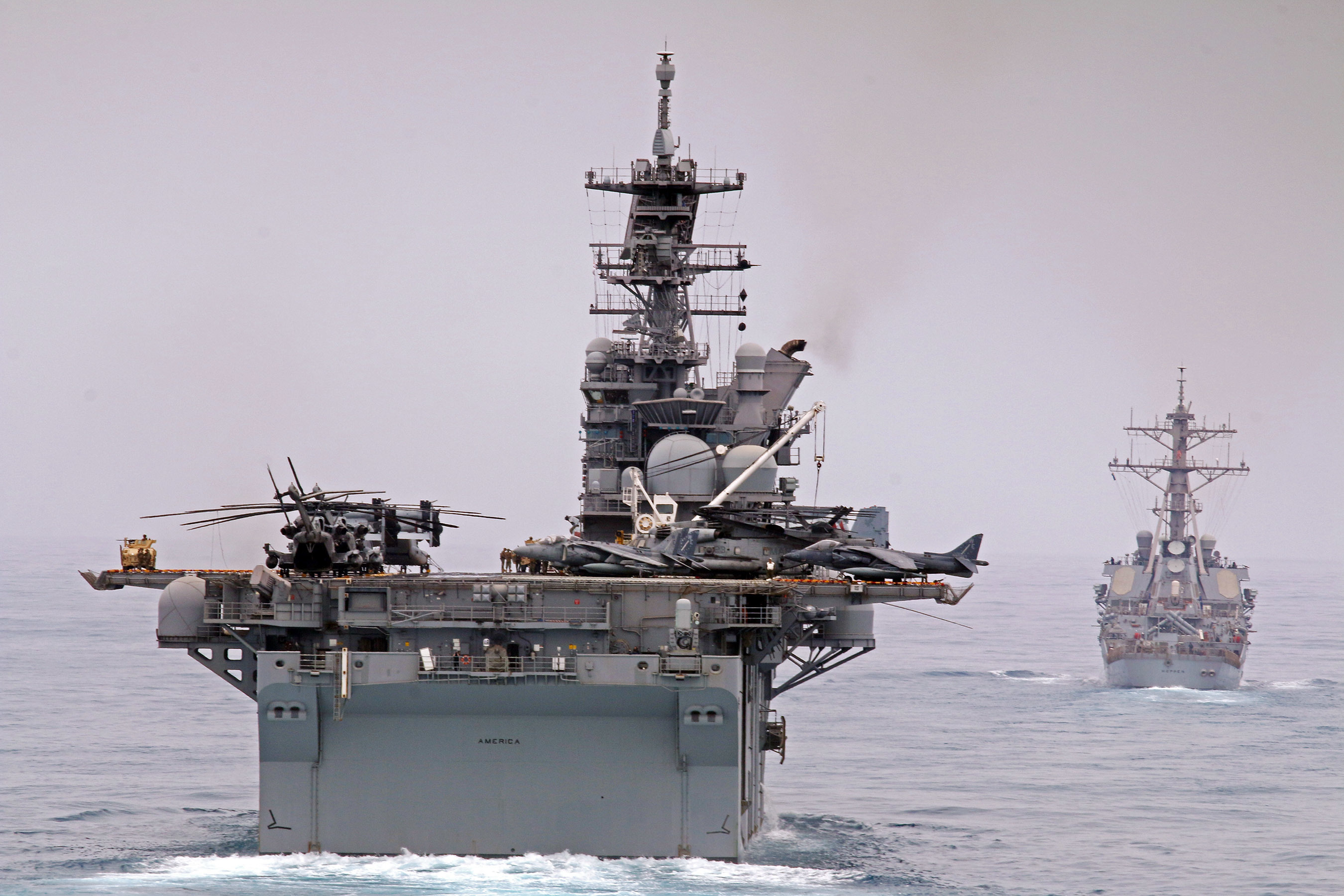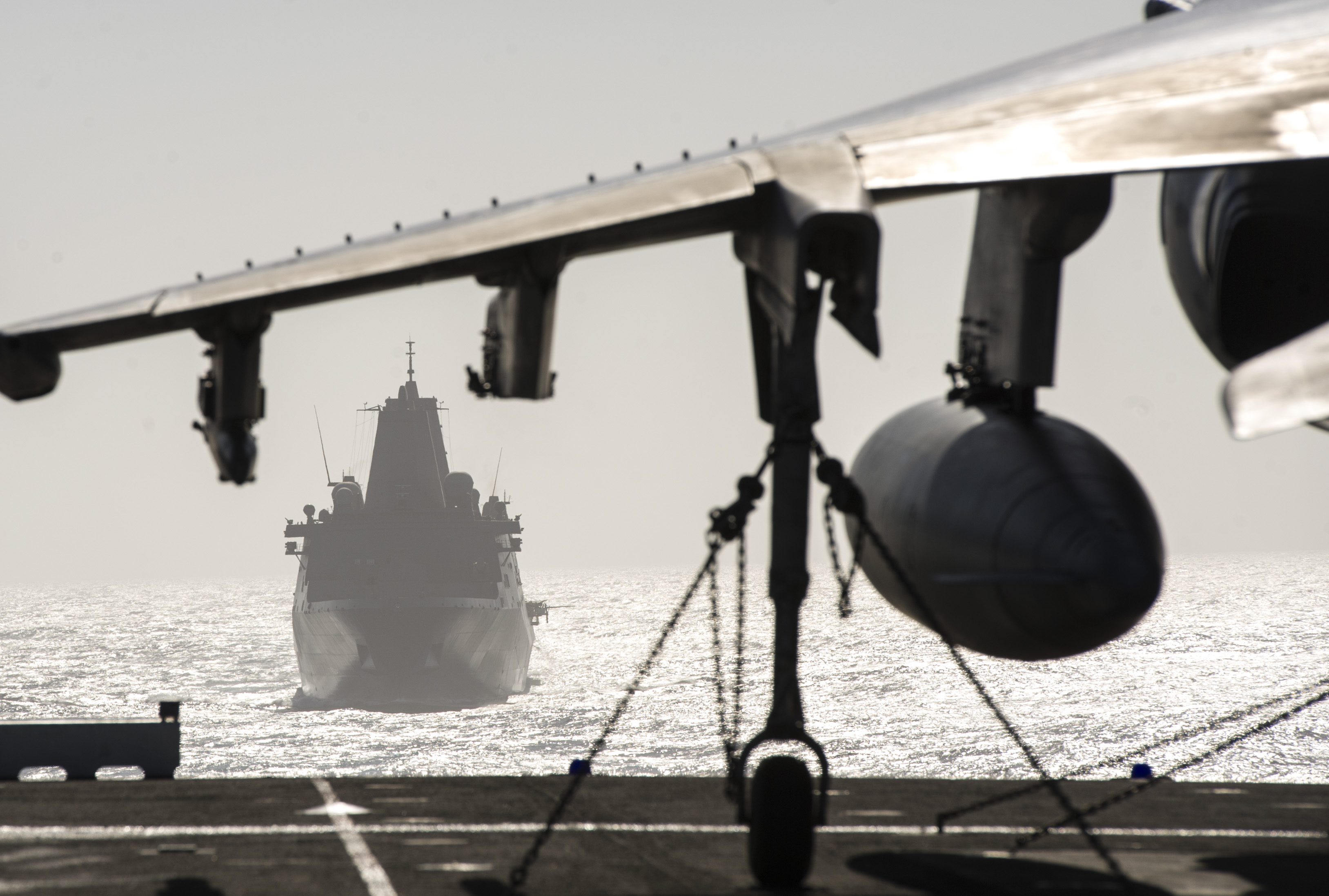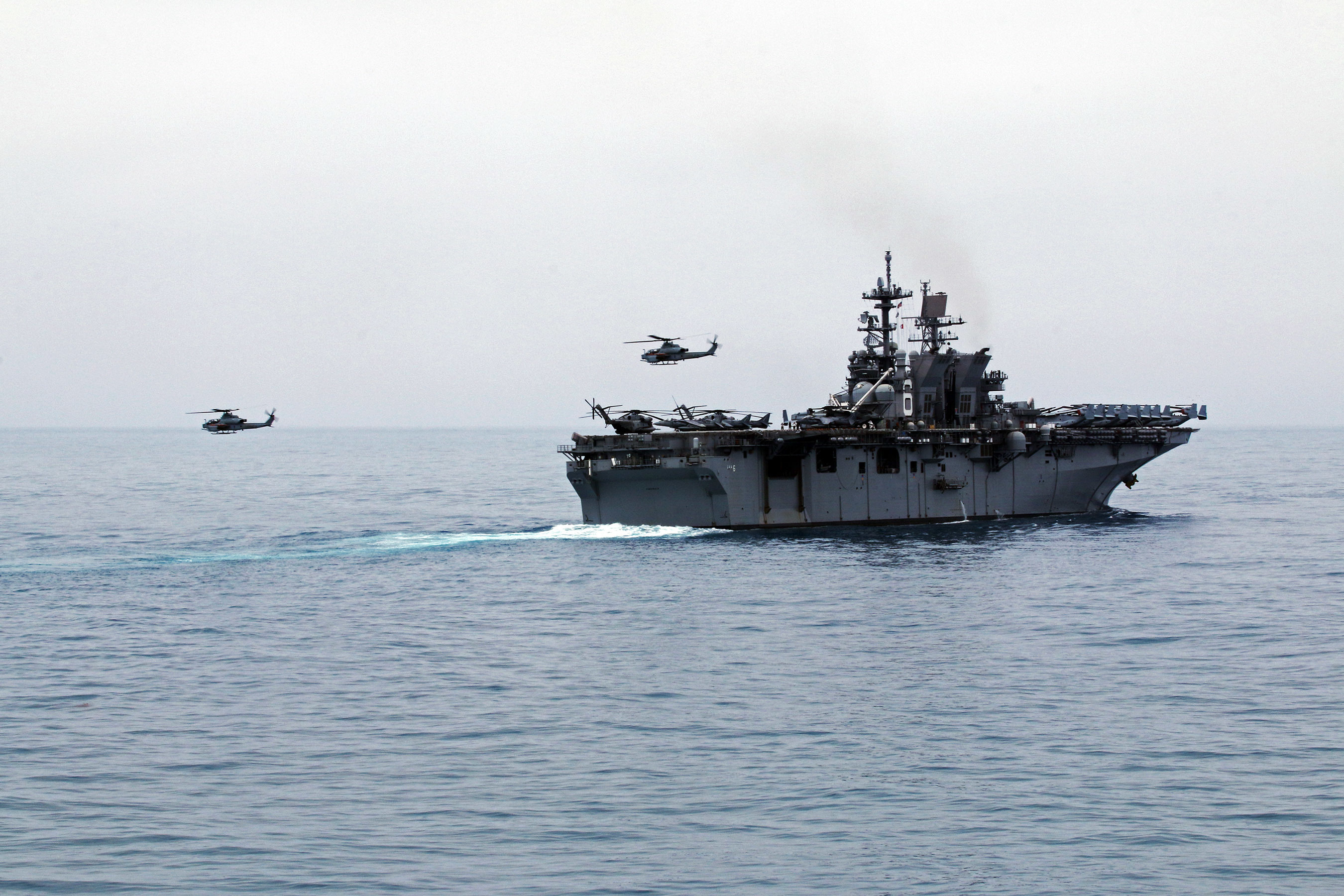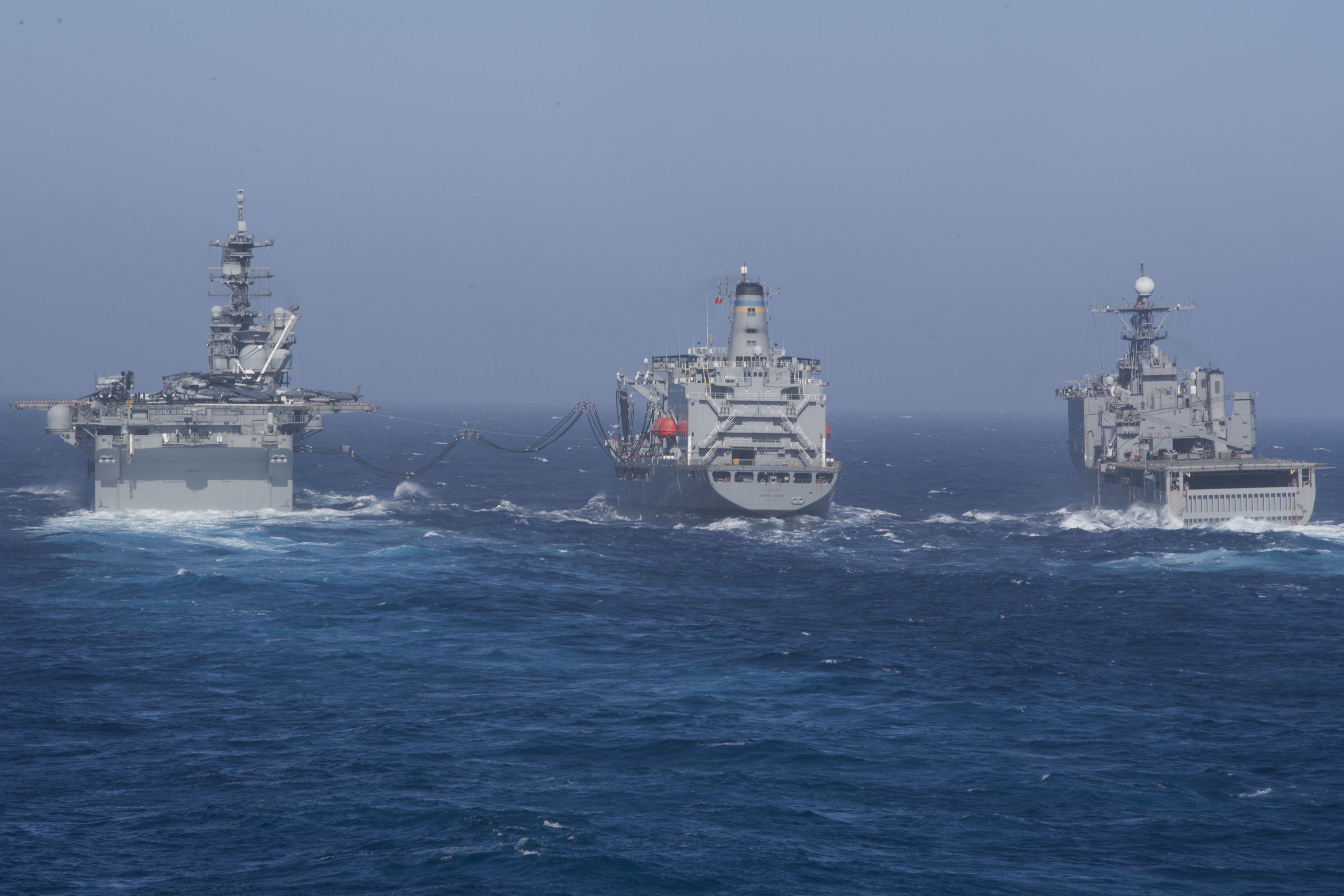
As the first-in-class USS America (LHA-6) begins operations on its first major overseas deployment, leadership has a good understanding of the basics of operating this new type of ship – an amphibious assault ship without a well deck – but also a lot of room to learn how to maximize the new capability it brings to the fleet.
Col. Joseph “J.R.” Clearfield, commanding officer of the 15th Marine Expeditionary Unit embarked aboard America, told USNI News earlier this year that the Marines and their Navy counterparts would experiment with several different loadouts of equipment on the three-ship Amphibious Ready Group – America, amphibious transport dock USS San Diego (LPD-22) and dock landing ship USS Pearl Harbor (LSD-52) – to validate what does and doesn’t help the warfighters meet their missions.
Clearfield told USNI News on Tuesday, aboard America while transiting from California to Hawaii, that leadership found they had a lot of good options despite lacking a well deck.
“The LHA-6 was well wargamed out and there were several [memos] that came out about operational considerations. There were a whole series of them about what the ship, what it’s capabilities were and what it’s limitations were,” Clearfield said.
“I think they were pretty much spot on with the hangar bay being bigger and what we could unfold in it, with more fuel capacity, with you may need to rely more on heavy lift helicopters because there were no surface connectors. … I think all [pre-deployment training program] did was sort of validate that. So we had good operational considerations coming in, we went at it that way, and then during the workup all those operational considerations got validated.”
Capt. Rome Ruiz, commander of Amphibious Squadron 3, who took command partway through the pre-deployment workup, said the aviation-centric nature of the ship, as well as the advanced command, control, computers, communication and intelligence (C4I) capabilities on the ship, create a lot of flexibility for the operators. He said there was still much to learn about operating this type of amphib and that he and his team were looking to the Navy’s aircraft carriers for inspiration.

“Given the robust communications and intelligence capability of this ship, and being able to be networked, this ship – when you think about dominating the maritime battlespace, you start looking at projecting power, maritime security, those type of things, very similar types of stuff when you look at our aircraft carrier capability – so there’s some things we can learn from how they do operations that we can even leverage to be, whether it be more effective or more efficient, and one of those is the composite warfare command concept,” Ruiz said, referring to the command and control relationship between the at-sea force and the landing force within an Amphibious Ready Group.
“What really comes to concern is the defense of the amphibious task force, given that the threat environment is starting to get a lot more capable and a lot more bold. So how do we defend ourselves to ensure we can continue to project power and continue to do maritime security operations and to continue to maintain maritime dominance in the battlespace?
“What we’ve been doing, or what we’ve been learning, is how do we work better together, even when we’re disaggregated; how do we maintain our combat power when we’re miles and miles away. And a lot of that has to do with the capability of the aircraft, being able to have long legs to be able to do deep strikes if that’s necessary, to communicate; there’s all kinds of packages we can do from an aviation-centric standpoint,” Ruiz continued.
“So I guess what I’m getting at is, we’re at really a journey of discovery here with opening up and kind of uncorking what we can really maximize with this capability, and it’s also making us think differently about how we use the ships, whether it’s the LSD and using her in a different way, with helicopters or aircraft or whatnot. So it really again goes back to maximizing flexibility to get us where we want to be.”

That the leadership team is focused on maximizing the new potential this ship brings, instead of looking at how to compensate for the lack of a well deck, is important given the conversations around the future of the Navy fleet. America will be just one of two amphibious assault ships of its configuration – Tripoli (LHA-7) will be built with the same design, but Bougainville (LHA-8) will have a small well deck reinserted into the design, with some aviation capability and some medical spaces sacrificed to reach a compromise design.
However, there are many supporters of the idea of using America as a launching point for a “light carrier” idea. The Center for Strategic and Budgetary Analysis included the America-based concept in its Future Fleet Architecture study delivered to the Navy earlier this year, and the Senate Armed Services Committee in its Fiscal Year 2018 defense bill sets aside $30 million for the Navy to conduct a preliminary design effort. The light carrier would add a catapult or two to the America-class’s straight flight deck to allow for larger fixed-wing aircraft, such as the Navy’s E2-D Advanced Hawkeye command and control plane, to operate as part of the ARG/MEU.
Though the light carrier concept is still a notional one, the ARG is set for near-term advances in capability and therefore changes in how it can operate. Once F-35B Joint Strike Fighters begin deploying aboard amphibious assault ships, that plane’s sensing and computing power, plus the long legs of the MV-22 Osprey, the heavy lift capability of the CH-53E today and CH-53K in a couple years, and the C4I power on the ship, would create a powerful combination that goes beyond traditional amphibious operations. The efforts by the America ARG, 15th MEU and PHIBRON 3 during this first deployment are sure to shape future efforts to leverage America’s high-end capabilities.
Ruiz said he doesn’t feel the ARG/MEU team is giving up anything by not having well deck space on the big-deck ship: “we can go in closer to shore to do things, and we can stay far our from shore and do things. And we can do it fast through the Ospreys and the (AV-8B) Harriers, or we can do it a little slower but with more lift with our helos. Three’s just so many options, we’ve got a menu of options to do to get after whatever we’re tasked to do.”
Clearfield agreed that this new ship doesn’t take away from his ability to move Marines ashore but rather provides “tailorability and flexibility; you can reconfigure to accomplish the mission.”

Capt. Joe Olson, America commanding officer, also played down the notion that anything was being lost by not having a well deck, saying that his ship was still able to conduct all the missions the Navy asked of it, such as contributing to battlespace awareness, while supporting the Marines.
“Just because we’re relying heavily on aviation, I think we still have the ability to do a lot of mission-essential tasks that the Navy puts out there for us to do as we operate over the horizon, if you will, all over the world,” Olson said.
“So while the ship is aviation-centric, there’s still plenty of other things we do onboard the ship to support all the Navy missions, plus the Marine Corps missions. We just happen to not have a well deck.”
The America ARG departed San Diego on July 7 and is expected to operate in the Pacific, the Middle East and the Horn of Africa during its first operational deployment overseas. The ship, which commissioned in October 2014, participated in last year’s Rim of the Pacific exercise in Hawaii as a lead-up to deploying this year.





